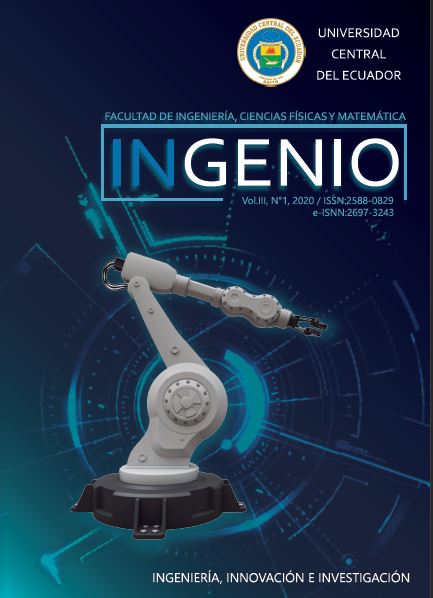Influence of the Soil Structure Iteraction (ISE) on Surface Foundations and Cohesive Soils in the Structural Behavior of an Eight-Story Basement Building
Main Article Content
Abstract
Vibration periods and floor drifts are obtained from traditional models with a rigid base (perfect embedment), and others, where the floor is represented with impedance functions and, directly by finite non-linear elements (direct method). An eight-level building and a subsoil is used as the base project, which interacts with a soft non-cohesive soil. For the seismic loads were considered: the spectrum of the Ecuadorian Standard of Construction and the site, which corresponds according to the location of the project, to the one generated by the segment of the Quito fault called Puengasí. Additionally, time-scaled stories are used according to the site spectrum. The non-linear behavior of the structure is achieved by means of plastic ball joints. It is observed that the model that includes interaction through impedance functions varies up to 45% with respect to the rigid one, however, it gives conservative results with respect to the direct method.
Downloads
Metrics
Article Details

This work is licensed under a Creative Commons Attribution-NonCommercial-NoDerivatives 4.0 International License.
References
G. M. Martin, «Proceedings of the NCEER/SEAOC/BSSC Workshop on Site Response during Earthquakes and Seismic Code Revisions,» Univ. of Southern Calif, 1994.
Pacific Earthquake Engineering Research Center, «PER Ground Motion Database,» 25 09 2019. [En línea]. Available: www.ngawest2.berkeley.edu.
R. F. Obrzud y A. Truty, THE HARDENING SOIL MODEL-A PRACTICAL GUIDEBOOK, Préverenges: Structures, 2018.
T. Schanz, P. Vermeer y P. Bonnier, «The hardening soil model: Formulation and verification,» Beyond 2000 in Computational Geotechnics , p. 16, 1998.
PLAXIS, Material Models Manual, 2017.
A. Alvarado, Neotectonique et cinematique de la deformation continentae en Equador, Arrete: Universite de Grenoble, 2012.
J. Biarez y P. Hicher, «Elementary Mechanics of Soil Behaviour. Saturated remoulded soils,» 1994.
ASCE 7, Seismic Evaluation and Retrofit of Existing Buildings, Reston, Virginia: American Society of Civil Engineers, 2016.
Y. Nakamura, «A METHOD FOR ESTIMATING THE DYNAMIC CHARACTERIZATION OF THE SUBSOIL USING MICROTREMORS ON THE SOIL SURFACE,» p. 33, 1989.
Pacific Earthquake Engineering Research Center, «PER Ground Motion Database,» 04 06 2019. [En línea]. Available: www.ngawest2.berkeley.edu.
R. Aguiar, Espectros de control para la ciudad de Quito-Ecuador (Obtención de espectros mediante modelos determinísticos asociados a las fallas ciegas inversas de Quito), Barcelona: A.H. Barbat , 2015.
H. Parra , Desarrollos Metodológicos y aplicaciones hacia el calculo de la peligrosidad sísmica en el Ecuador continental y estudio e riesgo sísmico en la ciudad de Quito, Madrid: Desarrollos Metodológicos y aplicaciones hacia el calculo de la peligrosidad sísmica en el Ecuador continental y estudio e riesgo sísmico en la ciudad de Quito, 2016.
K. Campbell y Y. Borzognia, NGA-Wets2 Campbell-Bozornia Ground Motion Model for the Horizontal Components of PGA, PGV and 5% Damped Elastic Pseudo-Acceleration Response Spectra for Periods Ranging from 0.01 to 10 sec, Berkeley: Pacific Earthquake Engineering Research Center, 2013.
J. Kaklamanos, L. G. Baise y D. M. Boore, «Estimating Unknown Input Parameters when Implementing the NGA Ground-Motion Prediction Equations in Engineering Practice,» Earthquake Engineering Research Institute, p. 17, 2011.
N. Abrahamson, W. Silva y R. Kamai, «Summary of the ASK14 Ground-Motion Relation for Active Crustal Regions,» Earthquake Spectra, p. 39, 2014.
N. Abrahamson, W. Silvia y K. R., Update of the AS08 Ground-Motion Prediction Equation Based on the NGA-West2 Data Set, Berkeley: Pacific Earthquake Engineering Research Center, 2013.
B. Chiou y R. Youngs, Update of the Chiou and Youns NGA Ground Motion Model for Average Horizontal Component of Peak Ground Motion and Response Spectra, Berkeley: Pacific Earthquake Engineering Research Center, 2013.
PEER, Users Manual for the PEER Ground Motion Database Web Application, Pacific Earthquake Engineering Research Center, 2011.
NEC-SE-DS, Norma Ecuatoriana de la Construcción-Capitulo de Peligro Sísmico y Diseño Simoresistente, Quito, 2015.
NEC-SE-DS, Norma Ecuatoriana de la Construcción-Capitulo de Peligro Sísmico y Diseño Simoresistente, Quito, 2015.
NIST GCR 12-917-21, Solil-Structure Interaction for Building Structures, Gaithersburg: U.S Department of Commerce, 2012.
A. Chopra, Dinámica de estructuras, México Df: Pearson, 2014.
NEC-SE-DS, Norma Ecuatoriana de la Construcción-Capitulo de Peligro Sísmico y Diseño Simoresistente, Quito, 2015.
«Instituto Geofísico,» 02 10 2019. [En línea]. Available: www.igepn.edu.ec.
MIDAS, New experience Geotechnical analysis System, 2019.
U.S Geological Survey & Esc. Politécnica Nacional, «Mapa de Fallas y Pliegues Cuarternarias de Ecuador y Regiones Oceanicas Adyacentes,» USGS, Denver & Quito, 2003.

